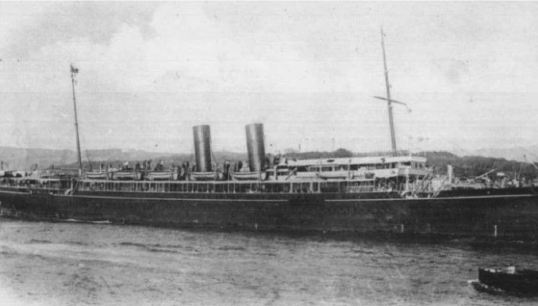Egypt

Converted and refitted
Launched in 1897, the 7,912grt vessel initially operated on services between the UK, India and Australia. In 1915, Egypt was taken over by the British Admiralty and converted into a hospital ship – remaining in government service until 1921.
Refitted and back on the India run, Egypt was en route to Bombay in May 1922 when it collided with the French cargoship Seine in thick fog some 25 miles off Ushant. Holed by the ice-strengthened bows of the French ship, Egypt sank in just 20 minutes with the loss of 86 lives.
Investigation
A formal investigation into the accident concluded that 'the loss of life was mainly due to default on the part of the master and chief officer'. The court's report pointed to a 'slackness and lack of discipline' which resulted in the ineffective use of life-saving appliances, compounded by an inadequate boat drill before the ship left port.
In a decision which prompted loud protests from the officers' unions, the court ruled that the Egypt's master, Captain Andrew Collyer, should have his certificate suspended for six months. It also severely censured the chief officer, Charles Cartwright.
Miscarriage of justice?
Claiming that 'a serious miscarriage of justice' had occurred, the Nautilus predecessor unions Imperial Merchant Service Guild and Mercantile Marine Service Association joined with the Association of Coastwise Masters, Mates, and Engineers to appeal against the 'wholly unwarranted' severity of the judgment. They said there were no grounds for holding the two men responsible for the deaths, which were largely due to the ship's rapid list and the failure of the French ship to render immediate assistance.
'If the finding of the Court is allowed to stand, the unions warned, 'it would mean that, should any loss of life occur, arising out of human failure and consequent panic in time of disaster, the master and mates of a ship would be liable to be branded with what amounts to a charge of manslaughter.'
However, the decision did stand, because the Board of Trade rejected the unions' case – on the grounds that the master could have appealed to the High Court.
Egypt fact file
Where was Egypt built?
Egypt was built at Caird & Company, Greenock
How heavy was Egypt?
Egypt had a tonnage of 7,912gt
How fast was Egypt?
Egypt had a service speed of 15 knots
Contribute
Are you knowledgeable about this vessel?
Submit your contribution to this article to our editorial team.
Write to usView more ships of the past
HMS Beagle
Launched 200 years ago, HMS Beagle has been described as one of the most important ships in history – thanks to the observations on evolution and natural selection that its famous passenger Charles Darwin made during a five-year voyage around the world between 1831 and 1836.
Common.ReadMoreHMS Beagle
Nicola
Launched in December 1967 at the Austin & Pickersgill (A&P) yard in Sunderland, the 9,034grt general cargoship Nicola was the first in a series of more than 200 British-designed vessels intended to replace the 'cheap and cheerful' Liberty ships built by the US during the Second World War.
Common.ReadMoreNicola
Oakleaf
Towards the end of the 1970s, the Royal Fleet Auxiliary managed to benefit from the downturn in world shipping by picking up five newly-built tankers that were laid-up after their ordering companies ran into problems.
Common.ReadMore